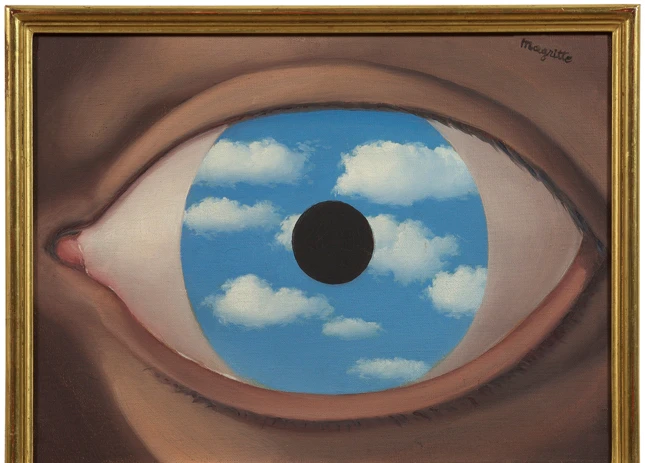In the mesmerizing world of Surrealist art, dreams take center stage, igniting a realm of imagination and exploration that knows no bounds. Surrealism, a revolutionary artistic movement born in the early 20th century, sought to unveil the mysteries of the unconscious mind and challenge conventional notions of reality. Central to this movement was the belief that dreams held profound significance, acting as portals to a hidden realm of creativity and truth. Surrealist artists delved deep into the realm of dreams, using them as a catalyst for their artistic expression. Join us as we venture into the enigmatic role of dreams in Surrealist art, uncovering the techniques, inspirations, and profound impact they had on this captivating artistic movement.
History of Surrealist Art
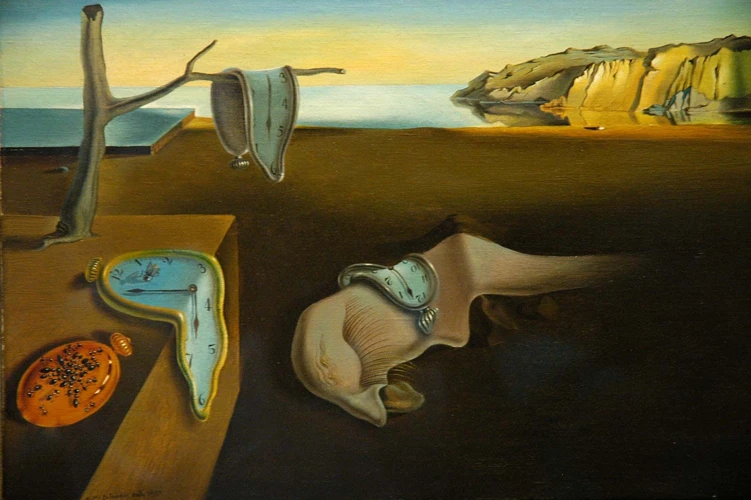
Emerging in the early 20th century, Surrealist art was a movement that sought to unlock the power of the unconscious mind and liberate the imagination from the constraints of rationality. It was heavily influenced by the earlier movement of Dadaism and its rejection of societal norms and traditional artistic techniques. The roots of Surrealism can be traced back to the aftermath of World War I, when a group of poets and writers, including André Breton, came together in Paris to explore the depths of the human psyche. In 1924, Breton released the Surrealist Manifesto, which served as a guiding light for the movement. Surrealism was characterized by a fascination with dreams, the irrational, and the subconscious. Artists embraced automatic drawing and painting, allowing their unconscious mind to guide their artistic creation. They sought to create works that challenged the viewer’s perception of reality and provoked a sense of unease. Surrealist art often featured bizarre and dreamlike imagery, filled with unexpected juxtapositions and symbolism. The movement had a profound influence on various art forms, including literature, photography, cinema, and sculpture, and its legacy continues to resonate in contemporary art today. So, let us delve deeper into the mesmerizing history of Surrealist art and uncover the fascinating interplay between dreams, the subconscious, and artistic expression.
The Surrealist Movement
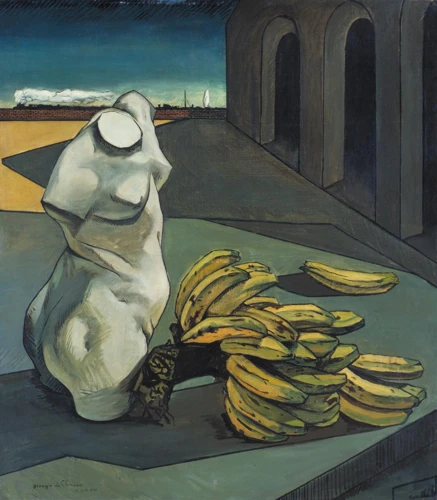
The Surrealist movement, born in the early 20th century, sought to shatter the constraints of reality and delve into the depths of the unconscious mind. Led by influential figures such as André Breton, Salvador Dalí, and René Magritte, Surrealism embraced the power of dreams, symbolism, and the irrational. It aimed to challenge societal norms and conventional artistic techniques, pushing the boundaries of imagination and exploring the realms of the subconscious. Surrealists believed that dreams held hidden truths and that by accessing these dreamscapes, they could tap into a wellspring of inspiration and creativity. Through their art, they aimed to provoke thought, provoke emotions, and unlock the mysteries of the human psyche. The Surrealist movement had a profound impact on various art forms, breaking new ground in literature, visual arts, cinema, and more. It continues to captivate audiences and inspire contemporary artists as we strive to unravel the profound link between dreams, the surreal, and artistic expression.
Key Characteristics of Surrealism
The Surrealist movement was defined by a set of key characteristics that distinguished it from other art movements of its time. One of the fundamental aspects of Surrealism was its fascination with the unconscious mind and the exploration of dreams. Dreams played a significant role in Surrealist art, providing artists with a gateway to the hidden recesses of the psyche. Another characteristic of Surrealism was its emphasis on the irrational and the fantastical. Surrealist artists sought to break free from the limitations of rationality and logic, embracing the irrational as a means of unlocking new realms of creativity. They often employed unexpected juxtapositions and bizarre imagery to challenge the viewer’s perception and provoke a sense of wonder and curiosity. Symbolism also played a crucial role in Surrealism, as artists used symbols to convey hidden meanings and evoke emotions. Colors, in particular, were frequently employed to create mood and convey psychological states. The Surrealist movement also embraced the concept of automatism, allowing the subconscious mind to guide artistic creation. This approach, known as automatic drawing and painting, aimed to bypass conscious control and access the raw creativity of the unconscious. Surrealism was a groundbreaking movement that pushed the boundaries of artistic expression, challenging societal norms and exploring the depths of the human psyche. Its key characteristics continue to inspire artists to this day, blurring the lines between reality and imagination. So, let us dive deeper into the captivating world of Surrealism and uncover how dreams became an integral part of this artistic revolution.
The Power of Dreams

At the heart of Surrealist art lies the profound power of dreams. Dreams have long captivated the human imagination, serving as a gateway to realms beyond the conscious mind. In Surrealist art, dreams became a wellspring of inspiration, allowing artists to delve into the depths of the subconscious and tap into a source of untamed creativity. Dreams were seen as a portal to a parallel reality, where the limitations of the rational world dissolved, and the fantastical and the absurd took center stage. Surrealist artists believed that dreams held immense symbolism and meaning, a rich tapestry of images and emotions that could be translated onto the canvas or into other artistic mediums. By embracing the enigmatic language of dreams, Surrealist artists were able to unlock a world of uncensored expression,/symbolism-colors-dreams/ where reality blended with fantasy, and the boundaries of the conscious mind were pushed to their limits. Dreams became a driving force in unleashing the imagination and exploring the hidden recesses of the human psyche, ultimately transforming the landscape of art as we know it today.
The Significance of Dreams to Surrealist Artists
The significance of dreams to Surrealist artists cannot be overstated. Dreams were seen as a direct link to the subconscious mind, a realm of untapped creativity and hidden desires. For Surrealists, dreams served as a wellspring of inspiration, allowing them to tap into their deepest thoughts and emotions. They believed that by exploring the content of their dreams, they could access a deeper understanding of themselves and the world around them. The fantastical and often bizarre imagery found in dreams became a rich source of material for their artistic endeavors. Surrealist artists sought to capture the essence of dreams, with their illogical narratives and unexpected associations, in their paintings, sculptures, and writings. They aimed to break free from the constraints of reason and conventional reality, embracing the symbolic language of dreams to convey their innermost thoughts and desires. Dreams provided a space for artists to express their subconscious desires, fears, and anxieties in a way that was both personal and universal. Through their art, Surrealists aimed to challenge societal norms and perceptions, offering viewers a glimpse into the hidden depths of the human psyche. The significance of dreams to Surrealist artists extended beyond their individual works; it became a central tenet of the movement itself, shaping its philosophy and artistic approach. By delving into the realm of dreams, Surrealists sought to unlock the mysteries of the mind and create art that pushed boundaries and expanded the possibilities of artistic expression. The exploration of dreams played a pivotal role in the development and evolution of Surrealist art, leaving an indelible mark on the movement that continues to captivate audiences today. To explore further the intersection of dreams and other art forms, such as cinema, check out our article on dreams in film and cinema.
Surrealist Techniques for Dream Exploration
Surrealist artists employed a variety of techniques to explore the rich realm of dreams and tap into the depths of their subconscious minds. These techniques served as pathways to unlock the hidden recesses of their creativity and bring forth surreal and enigmatic imagery. Automatic drawing and painting was one such technique, where artists would let their hand flow freely across the canvas, allowing their unconscious mind to guide the creation process. This method aimed to bypass rational thought and access raw, unfiltered emotions and ideas. Another technique utilized by Surrealist artists was frottage, where the artist would place a sheet of paper over a textured surface and rub it with a pencil or charcoal, generating random patterns and shapes that could act as a springboard for inspiration. Decalcomania was yet another method employed, involving the application of paint or ink to a surface and then pressing another surface against it to create unpredictable and abstract patterns. These dream-inspired techniques allowed Surrealist artists to access a realm of images and ideas that could not be accessed through traditional artistic methods. By embracing the subconscious and the dreamscape, they were able to create artworks that blurred the lines between reality and the surreal, inviting viewers to join them on a journey into the fascinating world of the unknown. To learn more about the intersection of dreams and abstract art, follow the link here.
Famous Surrealist Artists and their Dreams

Some of the most renowned Surrealist artists drew inspiration from their own subconscious dreams to create extraordinary works of art. Salvador Dalí, known for his eccentricity, utilized his dreams as a way to tap into the depths of his imagination. In fact, he famously said, “I don’t do drugs. I am drugs.” Dalí’s dreams influenced his iconic paintings, such as “The Persistence of Memory,” where melting clocks symbolize the distortion of time within dreams. Another prominent artist, René Magritte, explored the use of dream symbols in his art. His paintings often featured mysterious and symbolic elements, inviting viewers to contemplate the hidden meanings behind everyday objects. For instance, in “The Son of Man,” a bowler-hatted man obscures his face with an apple, presenting a dreamlike juxtaposition of familiar and enigmatic elements. These artists, among others, became masters at translating their surreal dreams into captivating visual experiences that continue to mesmerize audiences to this day.
Salvador Dalí and the Surrealistic Manifesto
One of the most iconic figures in Surrealist art is Salvador Dalí, renowned for his eccentric personality and captivating works. Dalí played a significant role in the Surrealist movement and his association with the Surrealist Manifesto solidified his position as one of its key proponents. In 1929, Dalí collaborated with his mentor and fellow Surrealist, André Breton, on the film “Un Chien Andalou,” a project that aimed to challenge the conventions of narrative cinema and explore the mysterious connections between dreams and reality. The film, with its provocative and bizarre imagery, was met with both fascination and controversy, establishing Dalí as a prominent figure within the Surrealist movement. Dalí’s artistic techniques often involved capturing the whimsical and enigmatic nature of dreams on canvas. He employed meticulous attention to detail, precise rendering, and skillful manipulation of perspective to create dreamlike landscapes and surreal scenarios. Dalí’s masterpiece, “The Persistence of Memory,” is a prime example of his ability to transport viewers to a dreamlike realm, where melting clocks and distorted figures evoke a sense of the surreal and a profound reflection on the nature of time and existence. With his vivid imagination and profound understanding of the power of dreams, Dalí contributed greatly to the exploration and manifestation of Surrealist ideas, forever leaving his mark on the movement.
Rene Magritte and the Use of Dream Symbols
Rene Magritte, a Belgian Surrealist artist, was renowned for his intriguing and thought-provoking artworks that often featured dream symbols. His paintings employed a meticulous attention to detail, juxtaposing seemingly unrelated objects to create a sense of mystery and intrigue. One of his most famous works, “The Treachery of Images,” depicts a pipe with the inscription “Ceci n’est pas une pipe” (This is not a pipe), challenging the viewer’s perception and highlighting the deceptive nature of images. Magritte’s fascination with dream symbols stemmed from his belief that everyday objects could hold hidden meanings and provoke a sense of wonder. He incorporated elements such as clouds, birds, bowler hats, and umbrellas into his compositions, imbuing them with symbolic significance that defied logical interpretation. Through his use of dream symbols, Magritte aimed to disrupt traditional narratives and blur the boundaries between reality and the subconscious. His artworks continue to captivate audiences with their enigmatic imagery, inviting viewers to question the nature of perception and the deeper meaning behind commonplace objects.
Here are some remarkable artworks by Rene Magritte that exemplify his use of dream symbols:
– “The Son of Man” (1964): This iconic painting depicts a man in a bowler hat with an apple obscuring his face. The apple, a symbol of temptation and forbidden knowledge, suggests a hidden identity or secret lurking beneath the surface.
– “The Lovers” (1928): In this artwork, a man and woman stand with their heads wrapped in white cloth, obscuring their facial features. Magritte’s use of the cloth symbolizes the intimacy and mystery of human connection, as well as the complexities of identity within relationships.
– “Golconde” (1953): This painting shows a group of suited men floating in the air, defying the laws of gravity. The dreamlike scenario challenges our perception of reality and suggests a departure from the limitations of the physical world.
Rene Magritte’s use of dream symbols in his artworks invites viewers to engage with their own subconscious, tapping into the rich tapestry of human imagination and unlocking a world of hidden meanings and interpretations.
Dreams as Inspiration for Surrealist Art
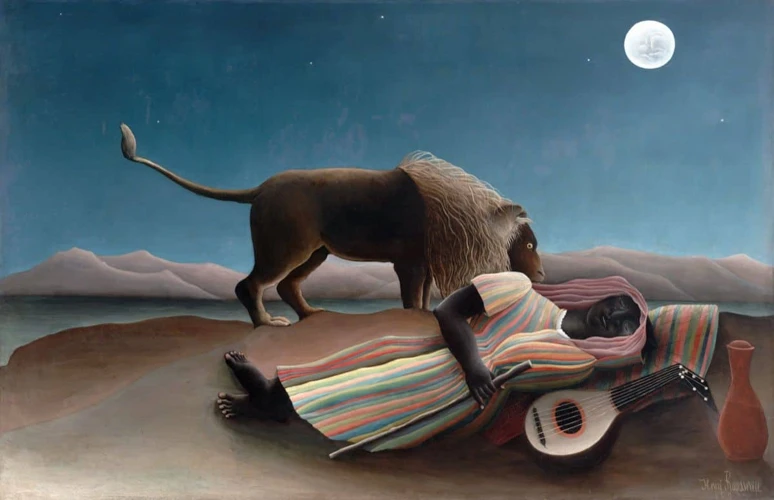
Dreams served as a wellspring of inspiration for Surrealist artists, fueling their creative processes and guiding their visual explorations. The enigmatic and often surreal nature of dreams resonated deeply with the movement’s aim of unveiling the subconscious mind. Surrealist artists drew upon the rich symbolism and imagery present in dreams to create artworks that challenged the boundaries of reality. They sought to capture the essence of dreams, which often featured fantastical elements, paradoxes, and unconventional narratives. The dreams became a source of liberation, allowing artists to tap into their innermost desires, fears, and fantasies. Through their art, Surrealists aimed to transport viewers into a world where the logical constraints of waking life were momentarily suspended, giving way to a realm of limitless possibilities. Dreams were a wellspring of inspiration for Surrealist masterpieces, as artists delved into the depths of their own subconscious minds and connected with universal elements of the human experience.
Unconscious Desires and Symbolism
Unconscious desires and symbolism play a vital role in Surrealist art, providing a channel for the exploration of the human psyche and its hidden depths. Surrealist artists believed that the unconscious mind held hidden desires, fears, and emotions that could be revealed through dream imagery and symbolism. Dreams acted as a direct connection to the unconscious, offering a glimpse into the innermost desires and fears of the dreamer. Artists such as Salvador Dalí and Max Ernst utilized symbolism to convey these unconscious desires in their artwork. Symbolic elements, such as melting clocks, floating objects, or distorted human figures, were employed to represent the irrational and dreamlike nature of the subconscious. Through symbolism, Surrealist artists aimed to challenge the viewer’s preconceived notions and tap into the universal collective unconscious. By representing these unconscious desires, they sought to provoke emotional responses, evoke curiosity, and encourage introspection. The use of symbolic imagery allowed for the manifestation of the human psyche in visual form, breaking free from the shackles of rationality and embracing the fantastical realm of the mind.
The Exploration of the Subconscious Mind
The exploration of the subconscious mind was a fundamental aspect of Surrealist art. Surrealist artists believed that by tapping into the depths of the unconscious, they could access hidden thoughts, desires, and emotions that were otherwise suppressed in everyday life. This became evident in the techniques they employed to delve into the subconscious realm. One such technique was automatic writing, where artists would let their pens move freely across the page, allowing their subconscious thoughts to flow without conscious control. This method aimed to bypass rational thinking and access a stream of unfiltered thoughts and ideas. Another technique was exquisite corpse, a collective exercise in which several artists would contribute to a drawing or piece of writing without seeing what the others had done before them. The result was a collaborative creation that reflected a collective subconscious exploration.
Dreams played a crucial role in the exploration of the subconscious. Surrealist artists recognized dreams as a direct link to the unconscious mind, a realm where desires and fears manifested in symbolic and often perplexing ways. By paying attention to their dreams and dissecting their symbolism, artists sought to unlock deeper meanings and tap into the enigmatic realm of the psyche. Dream journals became a common practice among Surrealists, allowing them to capture and analyze the imagery, emotions, and narratives of their dreams. These journals served as a wellspring of inspiration for their artistic endeavors, providing a rich source of ideas and symbolic motifs.
Through the exploration of the subconscious mind, Surrealist artists aimed to challenge societal norms, disrupt conventional thinking, and push the boundaries of artistic expression. By embracing the power of dreams and the mysterious workings of the mind, they created a groundbreaking movement that transformed the art world and opened doors to new realms of imagination and creativity.
Influence of Dreams on Surrealist Techniques
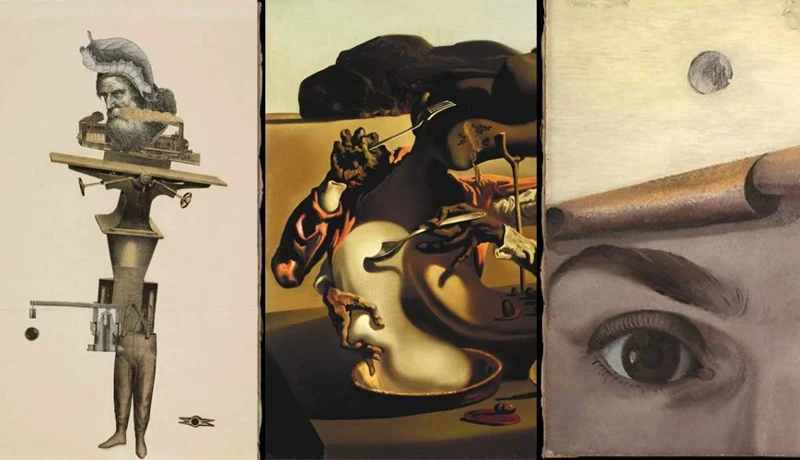
Dreams played a pivotal role in shaping the techniques employed by Surrealist artists, pushing the boundaries of artistic expression and challenging traditional norms. One prominent technique used by Surrealists was automatic drawing and painting, where artists would let go of conscious control and allow their hand to freely move across the canvas, guided by the unconscious mind. This technique aimed to tap into the raw, unfiltered imagery of dreams and channel it onto the canvas. Another technique embraced by Surrealists was decalcomania, which involved pressing wet paint between two surfaces and then separating them to create unique and unpredictable textures. This process mirrored the way dream images can transform, merge, and evolve. Additionally, Surrealists explored the technique of frottage, rubbing graphite or pencil onto a textured surface to create unexpected patterns and images, reminiscent of the way dream symbols can emerge from the unconscious mind. These techniques, along with others like collage and assemblage, allowed Surrealists to tap into the surreal nature of dreams and bring them to life on canvas, paper, or through three-dimensional works of art. The influence of dreams on Surrealist techniques gave birth to a new visual language that challenged conventional artistic practices and inspired a generation of artists to explore the depths of their subconscious minds.
Automatic Drawing and Painting
Automatic drawing and painting played a pivotal role in the Surrealist movement, allowing artists to tap into their unconscious mind and bypass conscious control. This technique involved creating artwork without preconceived notions or deliberate planning, giving free rein to the spontaneous flow of thoughts and emotions. Surrealist artists would often enter a state of trance or engage in automatic writing before translating their experiences onto the canvas. Through the use of automatic drawing, artists like André Masson and Joan Miró explored the realm of the subconscious, channeling their inner thoughts and dreams onto paper. The resulting artworks were a direct manifestation of the artist’s unconscious mind, revealing hidden desires, fears, and fantasies. Similarly, automatic painting allowed artists to unleash their creativity onto the canvas, embracing the unplanned and unexpected. By relinquishing control and embracing the untamed realm of the subconscious, Surrealist artists sought to tap into the raw essence of human experience and express the complexities of the psyche. Automatic drawing and painting became powerful tools for exploring the amalgamation of dreams, the unconscious, and artistic expression, helping to shape the distinctive style of Surrealist art.
Decalcomania and Frottage
Decalcomania and frottage were two innovative techniques embraced by Surrealist artists as a means of tapping into the unconscious mind and creating unique, dreamlike imagery.
- Decalcomania: This technique involved applying paint or ink to a surface, such as glass or paper, and then pressing another surface onto it and peeling them apart. The resulting pattern of random textures and shapes became the foundation for the artist’s work. Salvador Dalí, known for his eccentric and surrealistic style, employed decalcomania in many of his paintings, including his iconic work, “The Persistence of Memory.” The technique allowed him to create landscapes that resembled dreamscapes, filled with melting clocks and distorted landscapes.
- Frottage: Frottage involved placing a piece of paper over a textured object or surface and rubbing it with graphite or another medium, capturing the texture and creating unpredictable patterns. Max Ernst, one of the prominent Surrealist artists, used frottage extensively in his works. He would place the paper over various objects, such as wood grain, leaves, or fabrics, and by rubbing the surface, he would uncover hidden imagery and textures that served as a stepping stone for his artistic vision.
Both decalcomania and frottage allowed Surrealist artists to tap into the realm of the subconscious by embracing chance and spontaneity. These techniques, with their unpredictable outcomes, mirrored the unpredictability of dreams, enabling artists to create fantastical and symbolic imagery that would have been impossible to achieve through traditional means. Through these techniques, Surrealist artists were able to bridge the gap between the conscious and the unconscious, bringing the hidden depths of the mind to life on the canvas.
Collage and Assemblage
Collage and assemblage are distinct artistic techniques that played a significant role in Surrealist art, allowing artists to create new and unconventional compositions by combining disparate elements. Collage involves the juxtaposition of various materials such as newspaper clippings, fabric, photographs, and other found objects. Artists would cut and arrange these fragments, creating a new narrative or visual language that defied traditional artistic conventions. Assemblage, on the other hand, involves the construction of three-dimensional artworks by assembling found objects and incorporating them into a sculptural form. Surrealist artists saw collage and assemblage as a means to explore the mysterious and unexpected connections between objects and ideas, evoking dreamlike imagery and questioning the boundaries of reality. The use of collage and assemblage allowed artists to tap into the unconscious mind and express their dreams and deepest desires in unconventional and thought-provoking ways. Some notable examples of Surrealist artists who employed these techniques include Max Ernst, who created intricate collage novels, and Joseph Cornell, who constructed whimsical assemblage boxes that invited viewers into surreal and fantastical worlds. Through the use of collage and assemblage, Surrealist artists were able to blur the lines between reality and imagination, inviting viewers to explore the hidden depths of the subconscious mind.
The Surrealist Manifesto and Dream Interpretation
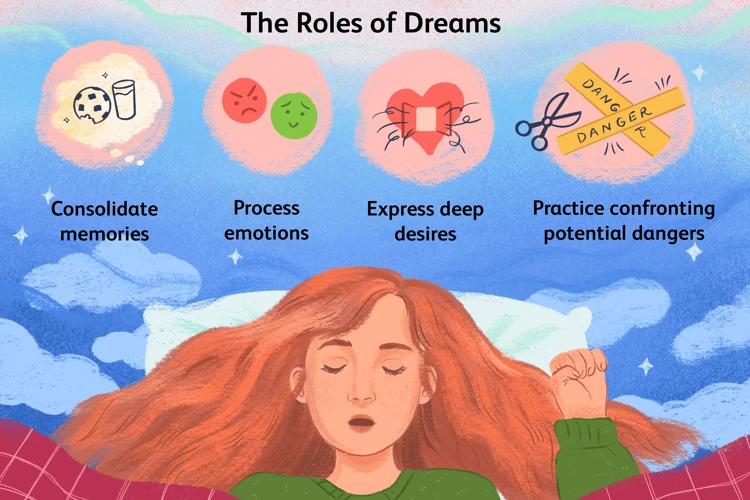
The Surrealist Manifesto, written by André Breton and published in 1924, served as the foundation for the Surrealist movement. It outlined the core principles and philosophies that guided Surrealist artists in their exploration of the subconscious and the role of dreams in their work. Breton believed that dreams held immense creative potential, as they provided a direct link to the unconscious mind. In the manifesto, he emphasized the importance of dream interpretation, encouraging artists to draw inspiration from their own dreams and delve into the symbolism and meaning hidden within them. Dream interpretation became a cornerstone of Surrealist art, with artists seeking to capture the mysterious and enigmatic aspects of dreams in their work. The Surrealists aimed to bypass conscious thought and tap into the realm of the subconscious, where dreams resided, to access deeper truths and unleash their imagination. This emphasis on dream interpretation allowed Surrealist artists to explore the complexities of the human psyche and push artistic boundaries. The Surrealist movement embraced the notion that dreams had intrinsic value and could provide insights into the human condition, paving the way for a new form of artistic expression that continues to captivate audiences to this day.
Dreams and Surrealistic Themes
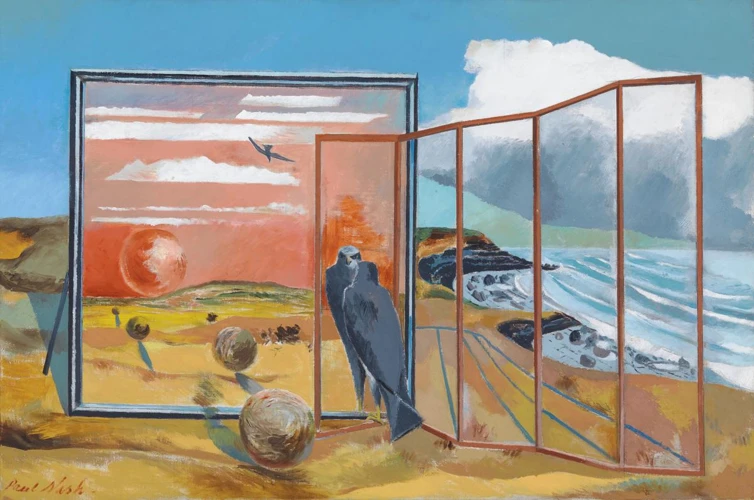
Dreams and surrealistic themes are intimately intertwined in the realm of Surrealist art. Surrealists believed that dreams held a profound significance, serving as a gateway to the depths of the unconscious mind. Within these dreams, surrealistic themes emerged, inviting artists to explore the limitless boundaries of their imagination. One prominent theme found in Surrealist art is transformation and metamorphosis. Artists depicted surrealistic scenes where objects and beings underwent fantastical changes, blurring the line between reality and the dream world. This theme of transformation often symbolized the fluid nature of the human experience and the constant state of flux in which we exist. Another prevalent theme is desire and repression. Surrealist artists delved into the realm of the subconscious, exploring hidden desires and repressed emotions. Their works often depicted provocative and sensual imagery, addressing the complexities of human desires and the societal constraints that suppress them. Finally, imagination and the fantastic were recurring themes in Surrealist art, with artists creating fantastical worlds filled with strange creatures, unusual landscapes, and whimsical scenarios. These themes allowed Surrealist artists to probe the depths of their unconscious mind and tap into the rich tapestry of dreams, resulting in artworks that challenge reality, provoke thought, and inspire wonder.
Transformation and Metamorphosis
In Surrealist art, the theme of transformation and metamorphosis holds a prominent position. Artists of the movement, such as Salvador Dalí and Max Ernst, were fascinated by the idea of the human form undergoing radical changes, blurring the boundaries between the real and the surreal. One striking example can be seen in Dalí’s iconic painting “The Persistence of Memory,” where clocks melt and morph into distorted shapes. This transformation serves as a metaphor for the fluid nature of time and the subconscious mind. The concept of metamorphosis can also be found in the works of René Magritte, who often depicted objects and figures in a state of transformative flux. For example, in his painting “The Son of Man,” a man’s face is obscured by an apple, symbolizing the potential for hidden identities and multiple layers of meaning. By portraying these metamorphic elements, Surrealist artists sought to challenge the viewer’s perceptions and provoke a sense of awe and wonder. Through the exploration of transformation and metamorphosis, Surrealist art allows us to confront the malleability of reality and embrace a world where the impossible becomes possible.
Desire and Repression
Desire and repression are recurring themes in Surrealist art, reflecting the movement’s fascination with the hidden desires and forbidden aspects of the human psyche. Surrealist artists sought to explore the depths of the subconscious mind, where unconscious desires and repressed thoughts reside. In their works, they often depicted symbols and imagery that evoked a sense of longing, eroticism, and liberation from societal norms. These depictions aimed to challenge the conventional ideas of desire and offer new perspectives on human sexuality and passion. Artists like Salvador Dalí and Max Ernst embraced the concept of desire in their artworks, using dreamlike imagery and symbolic representations to convey their innermost desires and fantasies. Through these representations, Surrealist artists aimed to disrupt the established order and provoke a sense of discomfort or unease in the viewer. By exploring the complex interplay between desire and repression, Surrealist art brought to the forefront the hidden aspects of human nature, allowing for a deeper understanding and examination of our innermost desires and fears.
Imagination and the Fantastic
Imagination and the fantastic played a pivotal role in Surrealist art, serving as a driving force behind the creation of dreamlike and otherworldly imagery. Surrealist artists sought to tap into the depths of their imagination, embracing the limitless possibilities that it offered. They aimed to challenge the boundaries of reality and transport viewers into a realm where the ordinary and the extraordinary converged. The fantastic elements in Surrealist art often featured bizarre creatures, mythical beings, and fantastical landscapes. These imaginative depictions were not intended to be literal representations but rather symbolic expressions of the unconscious mind. Through their use of symbolism and dreamlike imagery, Surrealist artists aimed to evoke a sense of wonder, mystery, and enchantment. By embracing the power of the imagination, they created art that was both captivating and thought-provoking. The fantastical elements in Surrealist artwork continue to inspire contemporary artists today, encouraging them to explore the depths of their own imagination and create artworks that challenge our perception of reality.
Influence of Dreams on Surrealist Architecture and Sculpture
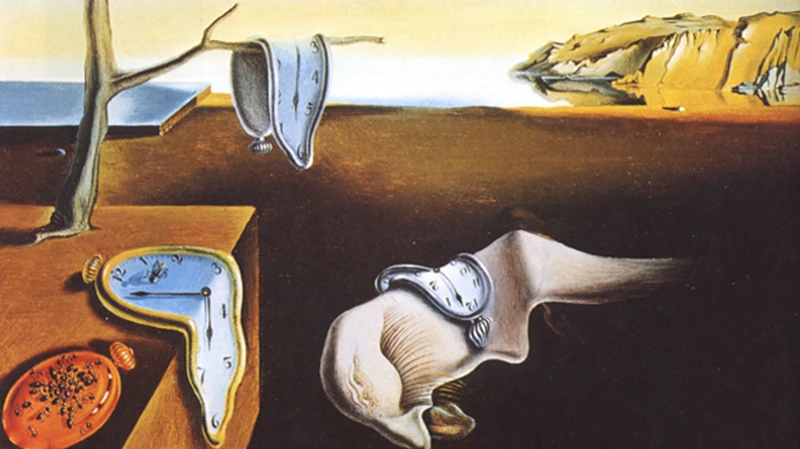
Dreams held a powerful influence on Surrealist architecture and sculpture, pushing the boundaries of the physical world and transforming reality into a realm of fantasy. Surrealist architecture aimed to create spaces that mirrored the enigmatic and irrational nature of dreams. Architects such as Antoni Gaudí and Friedensreich Hundertwasser embraced curvilinear forms, organic shapes, and intricate detailing in their designs, drawing inspiration from the fluidity of dreams. Gaudí’s famous Sagrada Familia in Barcelona, with its soaring spires and intricate ornamentation, evokes a sense of otherworldly beauty. Similarly, Surrealist sculptors were captivated by the dreamscape, and their works often showcased a distorted and surreal aesthetic. One notable sculptor was Alberto Giacometti, whose elongated and fragmented figures reflected the fleeting and ethereal quality of dreams. Another influential sculptor was Hans Bellmer, who created uncanny and disorienting dolls that challenged the boundaries of the human form. Surrealist architecture and sculpture elicited a sense of wonder and curiosity, inviting viewers to step into a world where reality and fantasy merge seamlessly. Through their imaginative visions, these artists transformed the physical realm into a dreamlike landscape that continues to captivate and inspire to this day.
Contemporary Surrealist Art and Dreams
In the ever-evolving landscape of contemporary art, Surrealism continues to captivate and inspire artists who are drawn to the power of dreams and the subconscious mind. Today, contemporary Surrealist art takes on new forms, blending traditional techniques with modern mediums and technologies. With the advent of digital art, artists have been able to push the boundaries of Surrealism even further, creating immersive and interactive experiences that transport viewers into surreal dreamscapes. The influence of dreams remains evident in the works of contemporary Surrealist artists, as they explore themes of identity, desire, and the complexity of human emotions. Dreams continue to serve as a wellspring of inspiration, allowing artists to delve into the depths of their subconscious and give shape to their most abstract and imaginative visions. In this new era, Surrealism continues to thrive as a vibrant and ever-evolving movement, reminding us of the enduring power of dreams to ignite our creativity and challenge our perceptions of reality.
Evolution of Surrealism in the Digital Age
In the digital age, Surrealism continues to evolve and find new avenues of expression. With the advent of advanced technology and digital tools, artists have been able to push the boundaries of Surrealist art even further. Digital art platforms, such as Photoshop and 3D modeling software, have provided artists with a whole new realm of possibilities to explore their subconscious and manifest surreal imagery. The ease of manipulating images and creating fantastical scenes has allowed artists to seamlessly blend dreamlike elements with reality, creating captivating and thought-provoking compositions. In addition to digital tools, the Internet and social media have become powerful platforms for artists to showcase their Surrealist creations and connect with a global audience. Artists can readily share their work, gain inspiration from others, and collaborate on surrealistic projects with like-minded individuals from around the world. This interconnectedness and accessibility have breathed new life into the Surrealist movement, fostering a vibrant and dynamic community of digital Surrealist artists. These artists continue to push the boundaries of what is possible, shedding light on the profound and ever-relevant relationship between dreams, the subconscious, and artistic expression in the digital realm.
Dreams as a Source of Inspiration for New Artists
Dreams have served as a rich source of inspiration for new artists, pushing the boundaries of creativity and giving rise to innovative and thought-provoking works of art. For contemporary artists, dreams offer a gateway to explore the subconscious mind, providing a wellspring of raw emotions, hidden desires, and untapped potential. By tapping into the surreal and fantastical elements of dreams, artists can create narratives that transcend reality and invite viewers into a world of mystery and wonder. The use of dream imagery allows artists to convey complex ideas and emotions that may be difficult to express through more conventional means. It enables them to challenge societal norms, question reality, and explore the depths of human experience. Just as the Surrealists drew inspiration from the dream realm, contemporary artists continue to harness the power of dreams, forging new paths in artistic expression. Through various mediums such as painting, sculpture, digital art, and mixed media, artists channel the enigmatic nature of dreams to create evocative and thought-provoking works that resonate with audiences on a visceral level. By embracing the influence of dreams, these artists contribute to the ever-evolving landscape of art, shaping and redefining the boundaries of creativity in the modern world.
Conclusion
In conclusion, the role of dreams in Surrealist art cannot be overstated. Dreams served as a wellspring of inspiration for Surrealist artists, allowing them to tap into the depths of their unconscious mind and explore the realms of the imagination. Through techniques such as automatic drawing, decalcomania, and collage, these artists sought to bridge the gap between the conscious and the unconscious, bringing forth surreal and thought-provoking imagery. Surrealist art challenged conventional notions of reality and embraced the power of symbolism and subconscious desires. From Salvador Dalí’s iconic melting clocks to René Magritte’s enigmatic dream symbols, dreams became a driving force behind the creation of some of the most captivating and influential artworks in history. The exploration of dreams in Surrealist art not only pushed artistic boundaries but also opened up new avenues for self-discovery and interpretation. As we reflect on the history, techniques, and themes of Surrealist art, one thing remains clear: dreams continue to hold a profound place in the world of art, offering a glimpse into the inner workings of the human psyche and inspiring the creation of works that challenge, captivate, and provoke.
Frequently Asked Questions
1. How did Surrealist art challenge traditional artistic techniques?
Surrealist art sought to break free from traditional artistic techniques by embracing the irrational and the subconscious. Artists utilized automatic drawing and painting, allowing their unconscious mind to guide their artistic creation. This created a unique and unpredictable artistic process that pushed the boundaries of conventional art.
2. What is the significance of dreams in Surrealist art?
Dreams held immense significance in Surrealist art as they were seen as gateways to the unconscious mind. Surrealist artists believed that by exploring and interpreting dreams, they could tap into a wellspring of creativity and reveal hidden truths about the human condition.
3. How did the Surrealist movement begin?
The Surrealist movement began in the aftermath of World War I when a group of poets and writers, led by André Breton, came together in Paris. They sought to challenge the rationality and conformity of society by exploring the depths of the unconscious mind and its connection to artistic expression.
4. What techniques did Surrealist artists use to explore their dreams?
Surrealist artists employed various techniques to explore their dreams, including automatic writing, automatic drawing, and painting. These techniques involved allowing the unconscious mind to guide the creation process without conscious control or censorship, enabling artists to tap into their deepest thoughts and emotions.
5. Who was Salvador Dalí and how did he contribute to Surrealist art?
Salvador Dalí was a renowned Surrealist artist known for his eccentric and highly symbolic artworks. He played a significant role in the Surrealist movement, advocating for the exploration of dreams and the subconscious. One of his notable contributions was the writing of the Surrealist Manifesto, which defined the principles and aspirations of the movement.
6. What role did dream symbols play in Surrealist art?
Dream symbols played a crucial role in Surrealist art as they provided a rich source of inspiration and meaning. Surrealist artists would often incorporate symbols from their dreams into their artworks, creating a visually enigmatic language that invited viewers to interpret and unravel the hidden messages within.
7. How did Surrealism influence other art forms?
Surrealism had a profound influence on various art forms beyond visual arts, including literature, photography, cinema, and sculpture. It revolutionized literature with its exploration of automatic writing, influenced the creation of dreamlike and symbolic narratives in cinema, and inspired the creation of sculptures that challenged traditional notions of form and material.
8. What is the relationship between Surrealism and the subconscious mind?
Surrealism emphasized the profound connection between art and the subconscious mind. Artists believed that by tapping into their own subconscious, they could tap into universal human experiences and emotions, creating deeply impactful and thought-provoking artworks.
9. How did Surrealist art break conventions of reality?
Surrealist art broke conventions of reality by embracing the irrational, unexpected, and dreamlike. Artists would often create juxtapositions of elements that defied logic or distorted familiar objects, challenging the viewer’s perception of reality and inviting them into a world of magic and mystery.
10. How does Surrealism continue to influence contemporary art?
Surrealism continues to be a powerful influence in contemporary art. Its emphasis on the subconscious, symbolism, and the exploration of dreams resonates with many artists today who seek to challenge boundaries, provoke thought, and engage viewers in imaginative and unconventional ways.

